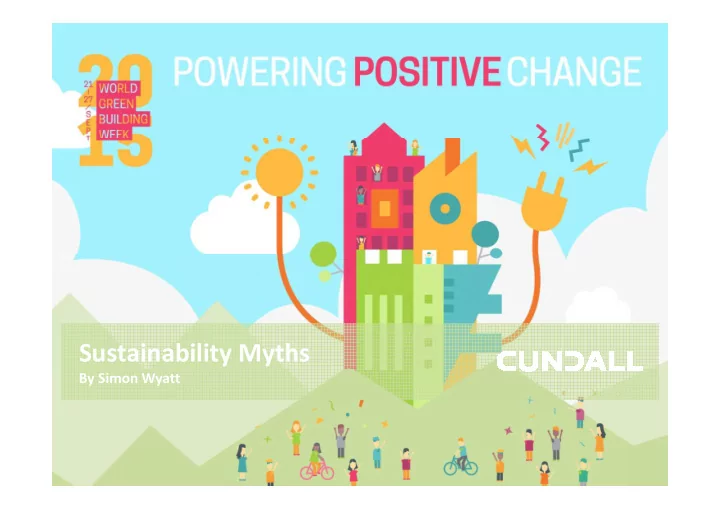

Biofuel in buildings v vehicles CHP in building connected to grid electricity and natural gas 10 litres of CHP efficiency recycled cooking oil Heat to power output ratio = 1.5 Efficiency = 75% No heat rejected Emission factors (kgCO 2 e/kWh) Recycled oil = 0.06 Diesel = 0.32 Grid electricity = 0.6 Natural gas = 0.2 CHP Truck Fuel Costs Biofuel & diesel = 70 p/litre (1 litre of fuel = 10 kWh)` Grid electricity = 10 p/kWh Nat gas =3.5 p/kWh CO 2 e saving 23kgCO 2 e 27kgCO 2 e Biofuel works better in transport Extra fuel cost 45% 0% Why waste it in Capital cost Lots Zero buildings?
Barriers to change
Is energy too cheap to drive change? “Between 2001 and 2011 not one prospective tenant enquired about the energy performance of a building before signing a lease, and only a handful asked about energy after the lease was signed.” Head of lettings, de-brief pending his retirement from a major quoted property company (>1 million m 2 )
Biggest cost is people £6,000 89% Assumptions Annual cost per m 2 of NLA Average salary = £43,000 £5,000 Employment cost (training, etc) = 30% Occupancy Density = 1 per 10m 2 of NLA £4,000 £3,000 £2,000 7% 2% 1% 0.6% < 0.5% £1,000 £0 Employee Rent Rates Service Energy Utilities / Costs Charge Consumption Standing Charges Source: What Colour Is Your Building, David Clark, RIBA Publishing 2013
Which is the lowest carbon operationally? A rated EPC BREEAM Excellent D rated DEC Alnwick London Manchester Don’t know – different benchmarks
EPC v actual consumption Actual energy consumption EPC Ratings No correlation between EPC (design) and measured energy consumption (reality) Source: A Tale of Two Buildings, JLL / BBP, 2012
An ‘A’ rated DEC? Benchmarking needs to include occupancy
The Performance Gap? Part L efficiency not consumption 60 50 DHW CO2 Emissions (kgCO2/m2) 40 Lighting Auxiliary 30 Cooling 20 Heating 10 0 BER TER Real Target Real Part L
Compliance Criteria 1 – CO2 Target Approved Software comparison 25 19.8% 20 17% 15 TAS IES 10.6% IES SBEM 10 ISBEM 4.2% 5 0 TAS IES IES SBEM ISBEM Good U Values
Calculations used for – Energy Performance Certificate (EPC) - no worse than E – BREEAM – SKA – CEEQUAL – Planning – Lifecycle Carbon – RIBA Sustainability Awards!
Whole carbon footprint
Initial embodied carbon > 50% is in structure Concrete (cement) is biggest component
Embodied v operating carbon (UK office) Refurb / Cat A fitout every 15 years, excludes Cat B fitout 81% 77%
To Bee or not to bee
Effective Land Use Organic farming uses 20-25% more land for the same output as Conventional methods with no proven health benefits. Could that land be better used?
Effective Land Use
Effective Land Use
But trees are not just about carbon
Local and Sustainable Food Carbon Footprint 27% attributed to food
Cheese v Chicken?
Food Carbon Comparison
Cows farting causes global warming? No. It’s their belching
Low carbon Hoofprint Innovation is required in agriculture. 30% reduction in carbon emission as a result of modified feed.
Food seasonality and low carbon diet thoughts SEASON OF FRUIT AND VEGETABLES WINTER SPRING SUMMER AUTUMN Dec. Jan. Feb. March Apr. May June July Aug. Sept. Oct. Nov. Apples Apples (Bramley) Apples (cox) Rhubarb F Blackcurrants R Cherries U Damson I Pears T Plums Quince Strawberries Raspberries Blackberries
Food seasonality and low carbon diet thoughts SEASON OF FRUIT AND VEGETABLES WINTER SPRING SUMMER AUTUMN Dec. Jan. Feb. March Apr. May June July Aug. Sept. Oct. Nov. Cabbage Asparagus Beetroot Brussels Sprouts V Broccoli E Carrots G Cauliflower E Celery T Celeriac A Leeks B L Marrow E Potatoes (Maincrop) S Lettuce Parsnip Peas Runner Beans Swede Sweetcorn
Summary
Recommend
More recommend